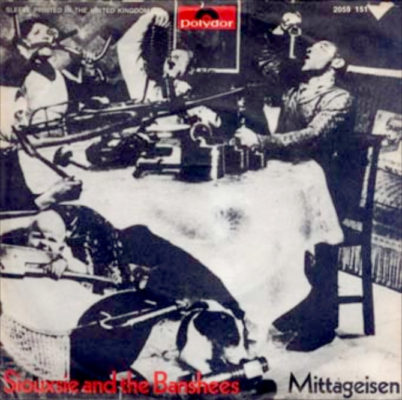Search
To search for an exact match, type the word or phrase you want in quotation marks.
A*DESK has been offering since 2002 contents about criticism and contemporary art. A*DESK has become consolidated thanks to all those who have believed in the project, all those who have followed us, debating, participating and collaborating. Many people have collaborated with A*DESK, and continue to do so. Their efforts, knowledge and belief in the project are what make it grow internationally. At A*DESK we have also generated work for over one hundred professionals in culture, from small collaborations with reviews and classes, to more prolonged and intense collaborations.
At A*DESK we believe in the need for free and universal access to culture and knowledge. We want to carry on being independent, remaining open to more ideas and opinions. If you believe in A*DESK, we need your backing to be able to continue. You can now participate in the project by supporting it. You can choose how much you want to contribute to the project.
You can decide how much you want to bring to the project.

Unlike other cultural manifestations, more closely linked to text, in the visual arts there is no separation into genres. There is no Art of Terror, no Thriller Art, or Crime Art, and there’s obviously no Comic Art.
Montse Badia in 2005 produced a modest exhibition more of an activity, within the context of QUAM, titled Mind the gap. At the time she asked ¿How could art have a real projection in society?
In Montse Badia’s article, that I’m selecting as reading for this summer, written in 2013: Satire and Parody as Critical Strategies, the author seems to sense a possible recipe for the dilemma that she herself proposed almost ten years before. By inviting us to adopt, within the context of the visual arts, communication strategies typical of popular culture. It’s a recourse that lamentably appears on very few occasions. It’s not by chance that the most commonly used word in pop music is love. In the visual arts, on the other hand, it would be: untitled.
Text selected: Satire and Parody as Critical Strategies by Montse Badia, published 18 January 2013
SATIRE AND PARODY AS CRITICAL STRATEGIES
In the field of branding, “baseline” is the advertising phrase that accompanies the brand in all the media supports used to promote it. Nike’s “Just do it”, Nokia’s “Connecting people”, the “Move your mind” of Saab or Apple’s “Think Different”. In colloquial terms, branding professionals refer to the “baseline” as “vaseline”, that is to say, the lubricant that helps the message “enter”.
In the context of culture, humour, parody and satire can have this “vaseline” effect, enabling authors to criticise facts, situations or questionable systems relentlessly. There are times when in which reality is so tough, disconcerting, unreasonable and unjust, that it seems as if it is only through parodied representations that one can agitate perceptions and consciences. One of these moments was in the convulsive thirties, that gave rise to the political photo-montages of John Heartfield (born Helmut Herzfeld): Adolf Der Übermensch: Schluckt Gold und redet Blech (Adolf, Superman: swallows gold and spouts junk), in which with the help of X rays one sees Hitler’s innards, a pile of golden coins; Goering: Der Henker des Dritten Reichs ((Goering, Executioner of the Third Reich) appears caricatured as a butcher or Hurrah, die Butter is alle! (Hurray! The butter is all gone), in which a family sitting around a table have nothing more to eat than bits of metal, in reference to the unfortunate phrase pronounced by Göring during a period of food scarcity, in which he affirmed that iron had always made the nation strong, while butter and lard only made people fat. It wasn´t by chance, that Hurrah, die Butter is Alle! was paid homage to, at an equally critical time, by punk, appearing on the cover of “Mittageisen” by Siouxsie and the Banshees.
The heirs to the photomontages of Heartfield or Jacob Kjeldgaard (who with the pseudonym Marinus realised critical photo-collages for the French newspaper Marianne) are now to be found in the written press, in satirical magazines like El Jueves, Karma Dice, Charlie Hebdo, or, the recently appeared Mongòlia “a satirical magazine without any message” that defined itself in a manifesto//[declaration>http://www.revistamongolia.com/que-es-mongolia/], makes its message quite clear including in each issue the section “Reality News”, with investigative articles (of the serious kind) in which reality exceeds any kind of parody.
In February 2006, Polònia, was born on TV3, the regional Catalan television, a programme of political satire, the very name of which used ironically the denomination “polacos”, a derogatory and colloquial term used to refer to Catalans. The current political scene has become such a parody of itself that the programme’s scriptwriters each week find it harder to surpass it. The portrait that Polònia makes of Catalan, Spanish and International society is as precise as it is relentless: Mas style, Obama and Bin Laden at the prow of a boat emulating the mythical scene from the film Titanic, before, oops, Bin Laden falls overboard or the Spanish Minister of Education, Culture and Sport, Jose Ignacio Wert, caricatured as a decrepit and perverse science fiction character, amongst others, configure a universe of caricatures of real people and situations, that function as a distorting mirror on a reality that is already fairly deformed.
But, what about art? Satire, irony or cutting mockery, are some of art’s recourses to criticise or denounce a certain reality. Honoré Daumier made cartoons about the things that he didn´t like, about the society that had to live in. William Hogarth elaborated “modern moral subjects” that were parodies of what he wanted to place in evidence. More recent examples are Dan Perjovschi, who makes drawings that take history as a continuum of events, or David Shrigley, whose drawings allude to the darker aspects of everyday existence. To make his works more accessible, Shrigley has no problem in using any type of channel or format. He is capable of making installations, photographs, sculptures, drawings, books, record covers, posters, tattoos, objects such as salt and pepper pots, interventions in shop windows and public spaces or even bookmarks.
But if we had to look for the equivalent of the Polònia-style in contemporary art it would be Maurizio Cattelan, capable of combining sculpture and performance and ridiculing whoever necessary, often transgressive, in relation to the spectator. His little Hitler reduced to kneeling or Pope Juan Pablo II struck by a meteorite are good examples of this and have become recurring images used to illustrate articles in the general press that periodically lances an “original” question, “Is this art?”. So what is the difference? How effective is the strategy? Polònia is television and Cattelan an artist who, though he can work in the public space, is always framed within the art system. Polònia doesn´t have to justify what it does as humour, television or political criticism, while Cattelan often has to justify what he does as art. The critical aspects are discussed afterwards and the humour, the “Vaseline” of humour, can end up being complicated for the complexity and sophistication that, ultimately, form part of the DNA of the art world.

Antonio Ortega is an artist and professor. On one occasion he was asked how it was that he liked to write and yet he did not like to read, to which he replied that for the same reason he liked to talk rather than to listen. Perhaps that is the reason why, whenever possible, he derives his artistic practice into lecture format.
"A desk is a dangerous place from which to watch the world" (John Le Carré)